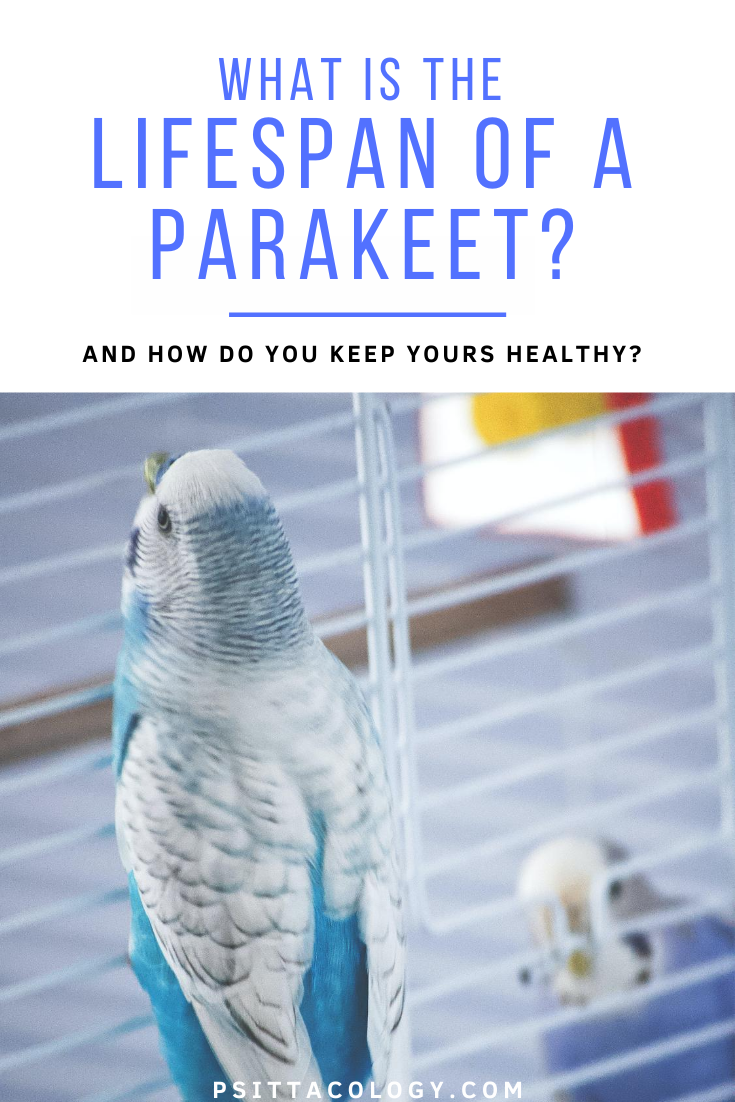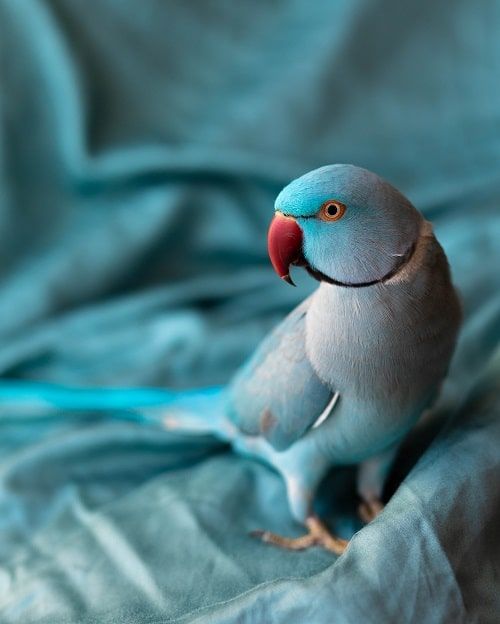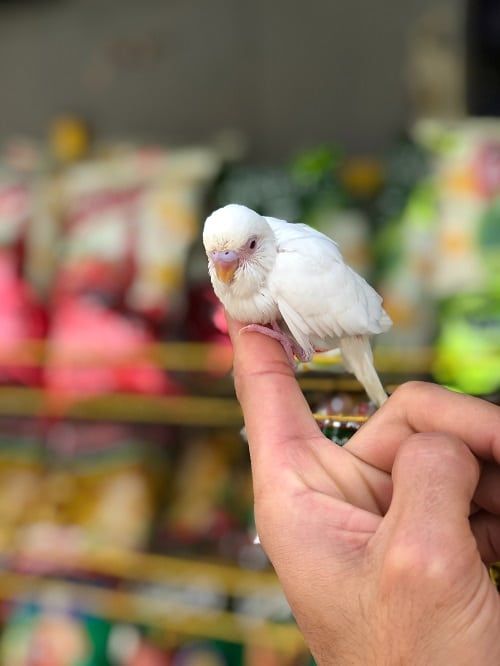If you’re thinking of adding a parakeet to your family, you might be wondering how long your feathered friend will be around for. What is the lifespan of a parakeet?
Let’s go into the lifespans of different parakeet species and what you can do to make sure yours reaches a respectable age.
How long does a budgie live?
“Parakeet” is a term used for a wide range of parrots with certain characteristics, like long tail feathers and a diet heavy in seeds. The most common one is the budgerigar (Melopsittacus undulatus), which is the most popular pet parrot species out there.
Budgies are small parakeets that originate from Australia. Despite their size, these guys actually have the potential to reach pretty surprising ages!
Most budgies pass away prematurely because they are still commonly seen as disposable pets. They’re cheap to buy and myths about their care are still rampant, causing many budgies to spend their lives locked in small cages eating a low-quality seed-based diet.
Due to the above, most budgies pass away before the age of 5. A real shame, because they actually have the potential to live for up to 20 years with good care and a healthy dose of luck. Budgies with a verified age of nearly 30 have actually been recorded!
If you’d like to know more about budgie lifespan, head over to the full article: How long does a budgie live?

What is the lifespan of a parakeet?
As mentioned about, budgies are the most popular type of pet parakeet. However, there are a whole bunch more parakeet species out there of all shapes and sizes! According to Wikipedia, in fact, there are about 115 species of parakeets.
As with all parrots, the lifespan of a parakeet is pretty impressive. It is of course true that many factors are involved, including luck and genetics. However, with good care and a healthy diet you can expect your parakeet to be around for at least a decade and usually even more.
The table below outlines potential lifespans for some of the more common pet parakeets. Note that some of the species aren’t usually referred to as parakeets, but they’re still classified as such.
Click the linked species for a full guide to their lifespans!
| Budgie (Melopsittacus undulatus) | 15-20 years |
| Rosy Bourke’s parakeet (Neopsephotus bourkii) | 10-15 years |
| Scarlet-chested parakeet (Neophema splendida) | 10-15 years |
| Eastern rosella (Platycercus eximius) | 20-25 years |
| Sun conure (Aratinga solstitialis) | 20-25 years |
| Green-cheeked conure (Pyrrhura molinae) | 20-25 years |
| Monk parakeet/quaker parrot (Myiopsitta monachus) | 20-30 years |
| Orange-chinned parakeet (Brotogeris jugularis) | 10-20 years |
| Lineolated parakeet (Bolborhynchus lineola) | 10-15 years |
| Indian ringnecked parakeet (Psittacula krameri) | 30-35 years |
| Alexandrine parakeet (Psittacula eupatria) | 30-35 years |
As you can see in the table above, all pet parakeets have an impressive lifespan. Therefore, before you take the plunge and decide to add one to your family, it’s extremely important to have a long hard think about where you see your own life going. For example, will you still be willing and able to care for your parakeet in 10 years? And how about 15, or 20?

What influences the lifespan of a parakeet?
Common mistakes
Now that we’ve established the lifespan of some common parakeets, let’s have a look at how to make sure yours actually has a good chance of reaching the upper ends of those numbers. As with many other pets, there are still many persistent myths out there about parakeet care.
The below outlines a number of the commonly made mistakes, many of which can unfortunately take years off your parakeet’s life.
- Small cage. Even the smallest budgie needs plenty of room to be able to fly around; the only exception would be if it’s only in its cage for sleeping. Without the ability to move, your bird is at high risk for obesity and muscle atrophy.
- No time out of the cage. Being able to explore outside of the cage for multiple hours a day is not just crucial to prevent obesity. It also gives the bird the opportunity to socialize with its owner and keeps things interesting, preventing stress from boredom.
- No socialization. A lot of people seem to forget that parakeets are extremely social beings that naturally live in large flocks. They absolutely thrive on being social with their owner and other parakeets. Without attention, they will wither away.
- No mental stimulation. Because parakeets are so smart, they need plenty of mental exercise to prevent boredom and stress. Time outside the cage helps greatly, as do (puzzle) toys and other fun new things to explore.
- Unhealthy diet. Many wild parakeets do almost exclusively eat seeds. However, a seed-based diet is just too fatty for their domestic counterparts! For more information, head over to the article on parakeet diet.
- Air quality. All birds have incredibly sensitive lungs. Certain things that don’t affect us humans at all can be fatal to them! Avoid cigarette smoke, perfume, non-stick pans, air fresheners, candles, bug spray and anything else that releases scents or fumes.
- Safety. Parakeets are often too curious for their own good and they can really get themselves into trouble. Any space that your ‘keet has access to should be free of hazards like open windows, hot stoves and other dangers.
- Veterinary care. Some parakeet owners feel it’s not ‘worth it’ to take their bird to the vet when it’s ill, as buying a new one is much cheaper. Not a mindset we’re a fan of here at Psittacology! Have the number for an avian vet handy and go for a vet check-up yearly.

How old is my parakeet?
In order to figure out how much longer your parakeet will be around, and whether it needs special care, it’s handy to know how old the bird is. If you got it directly from a breeder you’re usually in luck: they should know when a clutch hatched and your parakeet might even have a ring that states its hatch date!
But what if you got your parakeet from a pet store or as a rescue? Is there any way to figure out its age? For most species, unfortunately not. Very young birds are quite recognizable, as they’re still clumsy and their feathers might not have grown in yet. The budgie pictured above, for example, is clearly still a baby.
Other than that, only a few species show indicators of their age:
- Budgies of most color varieties will have stripes on the top of their head before their first molt at ~4 months. After that, they develop a spot without stripes.
- Budgies under 8 months will also have entirely black eyes, whereas older birds feature grey or brown irises.
- Male Indian ringneck and Alexandrine parakeets sport a black collar around their neck that starts to show up at around a year and a half in age.
- Sun conures that are less than a year and a half old will have more green plumage than their adult counterparts.
Some parrot enthusiasts claim they can tell a bird’s age from its feet and beak, which start looking more worn with age. Although this can likely tell you whether a parakeet is a juvenile or not, there is really not much of a visual difference between a 5-year-old one and a 35-year-old one!
Here is one thing that might help: If you have a budgie that you got from a pet store, it’s generally safe to assume it was less than a year old when you got it.
If you have any more questions about the lifespan of a parakeet or want to share your own experiences, don’t hesitate to leave a comment below!

1 thought on “How Long Does A Parakeet Live?”